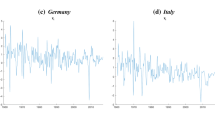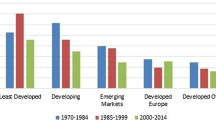Abstract
The paper aims to examine how fiscal and monetary volatility might affect the balanced economic growth rate using a standard monetary growth model characterized by nominal wage rigidity and productive public spending. The model shows that any type of shock — monetary or fiscal — can generate either a negative or positive relationship between short-run volatility and long-run growth, critically depending on the size of government and the elasticity of output with respect to labor/capital. In particular, given the labor income share, it shows that excessive government spending may cause the impact of fiscal volatility on long-run growth to turn from positive to negative. In addition, a rise in the volatility of the monetary shock is capable of generating either an increase or decrease in the mean of growth. With the range of the labor share values in reality, the model produces results consistent with the fact that the relationship between volatility and growth is generally found empirically to be more negative in developing than in developed countries. The model can be seen as a further explanation for the ambiguous empirical evidence in the existing literature.

Similar content being viewed by others
Notes
The assumption that utility is additively separable in consumption, real money balances, and labor supply allows for closed-form solutions. The budget constraint is also written without bond holdings for analytical convenience. For further simplicity, I also abstract from preference or technology shocks, since these shocks have been examined thoroughly in the existing literature.
If X and Y are independent random variables, then the second-order Taylor approximation of the expected value of the quotient X/Y is given by \( E\left[\frac{X}{Y}\right]\simeq \left(\frac{E\left[X\right]}{E\left[y\right]}\right)\left(1+\frac{Var\left[Y\right]}{{\left(E\left[Y\right]\right)}^2}\right) \).
References
Afonso A, Furceri D (2010) Government size, composition, volatility and economic growth. Eur J Polit Econ 26:517–532
Aghion P, Howitt P (1992) A model of growth through creative destruction. Econometrica 60(2):323–351
Aghion P, Saint-Paul P (1998a) VIRTUES OF BAD TIMES Interaction Between Productivity Growth and Economic Fluctuations. Macroecon Dyn 2(3):322–344
Aghion P, Saint-Paul P (1998b) Uncovering some causal relationships between productivity growth and the structure of economic fluctuations a tentative survey. Labour CEIS 12(2):279–303
Aizenman J, Marion N (1993) Policy Uncertainty, Persistence and Growth. Rev Int Econ 1(2):145–163
Annicchiarico B, Pelloni A, Rossiet L (2011) Endogenous growth, monetary shocks and nominal rigidities. Econ Lett 113(2):103–107
Barro RJ (1990) Government spending in a simple model of endogenous growth. J Polit Econ 98(5):103–126
Blackburn K, Galindev R (2003) Growth, volatility and learning. Econ Lett 79(3):417–421
Blackburn K, Pelloni A (2004) On the relationship between growth and volatility. Econ Lett 83(1):123–127
Blackburn K, Pelloni A (2005) Growth, cycles, and stabilization policy. Oxf Econ Pap 57(2):262–282
Brunetti A (1998) Policy volatility and economic growth: A comparative, empirical analysis. Eur J Polit Econ 14:35–52
de Hek PA (1999) On endogenous growth under uncertainty. Int Econ Rev 40(3):727–744
Dixit A, Stiglitz J (1977) Monopolistic Competition and Optimum Product Diversity. Am Econ Rev 67(3):297–308
Döpke J (2004) How robust is the empirical link between business-cycle volatility and long-run growth in OECD countries? Int Rev Appl Econ 18(1):103–121
Dotsey M, Sarte PD (2000) Inflation, uncertainty and growth in a cash-in-advance economy. J Monet Econ 45(3):631–655
Fatás A, Mihov I (2013) Policy Volatility, Institutions, and Economic Growth. Rev Econ Stat 95(2):362–376
Grier K, Perry MJ (2000) The effects of real and nominal uncertainty on inflation and output growth some GARCH-M evidence. J Appl Econ 15(1):45–58
Grier K, Tullock G (1989) An empirical analysis of cross sectional economic growth 1951–80. J Monet Econ 24(2):259–276
Hnatkovska V, Loayza N (2004) Volatility and growth. Policy, Research working paper; no. WPS 3184. Washington, DC: World Bank
ILO and OECD (2015) The Labour Share in G20 Economies. International Labour Organization and Organization for Economic Co-operation and Development, Report prepared for the G20 Employment Working Group Antalya, Turkey, 26–27 February 2015
Imbs J (2007) Growth and Volatility. J Monet Econ 54(7):1848–1862
Jetter M (2014) Volatility and growth: Governments are key. Eur J Polit Econ 36:71–88
Jones LE, Manuelli RE, Stacchetti E (1999) Technology (and policy) shocks in models of endogenous growth. Working Paper No. 7063, NBER, Cambridge, MA
Judson R, Orphanides A, (1999) International Finance 2(1): 117–138
Kormendi R, Meguire P (1985) Macroeconomic determinants of growth cross-country evidence. J Monet Econ 16(2):141–163
Loayza N, Rancière R, Servén L, Ventura J (2007) Macroeconomic Volatility and Welfare in Developing Countries. World Bank Econ Rev 21(3):343–357
Martin P, Rogers CA (1997) Stabilization policy, learning-by-doing, and economic growth. Oxf Econ Pap 49(2):152–166
Martin P, Rogers CA (2000) Long-term growth and short-term economic instability. Eur Econ Rev 44(2):359–381
Mirman LJ (1971) Uncertainty and optimal consumption decisions. Econometrica 39(1):179–185
Pham TA (2011) Growth, volatility and stabilization policy in a DSGE model with nominal rigidities and learning-by-doing. IEEP 8(3):307–322
Rankin N (1998) Nominal rigidity and monetary uncertainty. Eur Econ Rev 42(1):185–199
Schumpeter JA, Fels R (1939) Business Cycles, vol 1. Cambridge Univ. Press, Cambridge and New York
Scully GW (2003) Optimal taxation, economic growth and income inequality. Public Choice 115(3–4):299–312
Sheehey E (1993) The effect of government size on economic growth. East Econ J 19(3):321–328
Trapp K (2015) Measuring the labour income share of developing countries. United Nations University World Institute for Development Economic Research (WIDER) Working Paper 2015/041
Varvarigos D (2007) Policy variability, productive spending, and growth. Economica 74(294):299–313
Varvarigos D (2010) Inflation, volatile public spending, and endogenously sustained growth. J Econ Dyn Control 34(10):1893–1906
Author information
Authors and Affiliations
Corresponding author
About this article
Cite this article
Pham, T.A. Policy volatility and growth. Port Econ J 17, 87–97 (2018). https://doi.org/10.1007/s10258-018-0144-6
Received:
Accepted:
Published:
Issue Date:
DOI: https://doi.org/10.1007/s10258-018-0144-6




